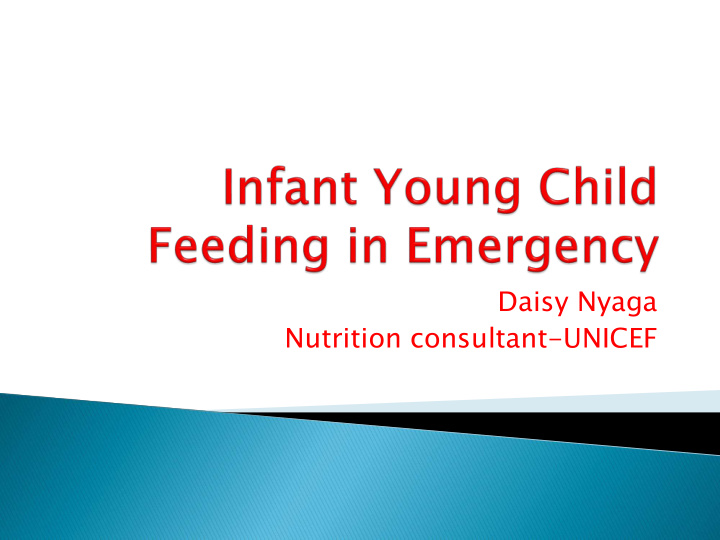



Daisy Nyaga Nutrition consultant-UNICEF
Promotion, protection and support of breast feeding to both the breast fed and non breast feed infant in emergency. Children 6-24 months are fed with foods from 4 or more food groups per day. Proper hygiene and safe food handling practices adhered to.
- The younger a child, the more vulnerable they are. - The younger a child, the more the value of breast milk. Thus the requirement to introduce breast milk within 1 st hour of birth. - Breast milk comes ready to use, with up todate nutritive value .
Ri Risks s of dea eath h highe hest st for the e yo younge ngest st IFE 1/2 at therapeutic feeding centres in Afghanistan, 1999 of admissions Deaths as % of Age (months ths) Golden M. Comment on including infants in nutrition surveys: experiences of ACF in Kabul City. Field Exchange 2000;9:16-17
Protec tection tion by y brea eastfeeding stfeeding is grea eatest test IFE 1/4 for the yo youngest ngest infants ants Times more likely to die die if not breastfed Risk of death if breastfed is equivalent to one. Age in months hs WHO Collaborative Study Team. Effects of breastfeeding on infant and child mortality due to infectious disease in less developed countries: a pooled analysis. The Lancet 2000;355:451-5
Common misconceptions on infant feeding in emergencies IFE PAK 1/8 Misconce onceptio ion Fact ct / Recom ecommenda ndatio tion “Stress makes the milk dry Stress might temporarily affect up” the milk let down reflex, but does not affect milk production. Mothers need reassurance and support “Malnourished mothers cannot breastfeed” Feed the mother and let her feed her infant. All mothers need extra fluids, food to “Once breastfeeding has stopped, it cannot be maintain strength and resumed ” breastfeeding. It is usually possible to re- lactate. Mothers need support to do this.
Common misconceptions on infant feeding in emergencies IFE PAK 1/9 Fact / Recommend ommendation ation Misconc conceptio ption Breastfeeding will relax both “If the mother is stressed, mother and baby. Mothers she will pass the tension on need reassurance and support. to the baby”. Breast milk provides all the “Babies in warm climate, get fluids an infant under 6 thirst and need water.” months needs, also when it has diarrhea The emergency means that the Women formula-fed here circumstances that made before the crisis & ‘know formula-feeding acceptable, how to do it’ feasible, affordable, (We are ‘developed’ and only formula feed) sustainable & safe have gone. Breastfeeding is best anyway – but especially in an emergency
Improvin proving g co conditi ditions ons IFE 1/8 to make e breastf stfeedi eding ng easier r in emerge genc ncy Staff ff sho houl uld ensu sure Mothers’ difficulties priority access, latrines at • time constraints breastfeeding havens long time to fetch water, queue for food, distance to latrines for PLWs Shelters, breastfeeding havens • lack of protection, security, and (where valued) privacy groups of women who support • lack of social support and the each other familiar social network • free availability of breastmilk substitutes,undermining effective controls on mothers’ confidence in availability breastfeeding
IFE PAK 1/15 Inappropriate donations of milk products Pakistan 2005 Lebanon, 2006 Ali Maclaine, Nutrition Consultant, Lebanon Maaike Arts, UNICEF Pakistan Maaike Arts, UNICEF Pakistan
Some e impor portan tant t points nts from om the e IFE 1/13 Inte ternati rnational onal Code of Marke keting ting of Breast t milk k Substi stitutes tutes • no advertising or promotion to the public • no free samples to mothers or families • no donation of free supplies to the health care system • health care system obtains breast milk substitutes through normal procurement channels, not through free or subsidised supplies • labels in appropriate language, with specified information and warnings
Problems blems of ar artifici ficial al fee eeding ing in em emer ergencies gencies IFE 1/11 • lack of water • poor sanitation • inadequate cooking utensils • shortage of fuel • daily survival activities take more time and energy • uncertain, unsustainable supplies of breastmilk substitutes • lack of knowledge on preparation and use of artificial feeding
Points nts of ag agreemen eement: t: ev ever ery y time e in touch ch with PLW IFE 1/16 1. Emphasise that breast milk is best. 2. Actively support women to breastfeed. 3. Discourage use of infant formula. HONDURAS. UNICEF/HQ98-0639/BULAGUER RWANDA. UNICEF/DOI94-1056/PRESS NGARA, TZ/LUNG’AHO
More e points nts of ag agreement eement IFE 1/17 on how to protect, promote and support breastfeeding 5. Stop and report any distribution of feeding bottles/teats; promote cup feeding. 6. Stop and report distribution of dried skim milk . Encourage handlers to mix dried skimmed milk with cereals before distribution. 7.Encourage mothers with children older than 6 months to introduce complementary foods together with breastfeeding. 8. Stop and report any in EX-Yugoslavia UNICEF/HQ-95-0505/LEMOYNE appropriate distribution of infant formula.
When absolutely necessary and when all other options have been explored and not possible, tandem nursing, wet nursing ,cup feeding etc. Then necessary following necessary assessment use infant formula can be made available. It must be targeted only to those who need it.
Recommend
More recommend